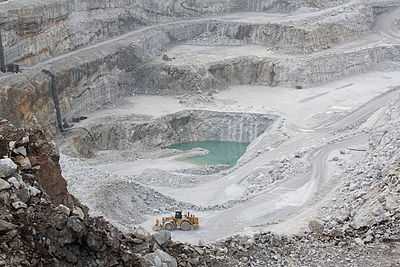Lime (material)

| Look up lime in Wiktionary, the free dictionary. |
Lime is a general term for calcium-containing inorganic materials, in which carbonates, oxides and hydroxides predominate. Strictly speaking, lime is calcium oxide or calcium hydroxide. It is also the name of the natural mineral (native lime) CaO which occurs as a product of coal seam fires and in altered limestone xenoliths in volcanic ejecta.[1] The word "lime" originates with its earliest use as building mortar and has the sense of "sticking or adhering."[2]
These materials are still used in large quantities as building and engineering materials (including limestone products, concrete and mortar) and as chemical feedstocks, and sugar refining, among other uses. Lime industries and the use of many of the resulting products date from prehistoric periods in both the Old World and the New World. Lime is used extensively for waste water treatment with ferrous sulfate.
The rocks and minerals from which these materials are derived, typically limestone or chalk, are composed primarily of calcium carbonate. They may be cut, crushed or pulverized and chemically altered. "Burning" (calcination) converts them into the highly caustic material quicklime (calcium oxide, CaO) and, through subsequent addition of water, into the less caustic (but still strongly alkaline) slaked lime or hydrated lime (calcium hydroxide, Ca(OH)2), the process of which is called slaking of lime.
When the term is encountered in an agricultural context, it probably refers to agricultural lime. Otherwise it most commonly means slaked lime, as the more dangerous form is usually described more specifically as quicklime or burnt lime.
Lime production process
Limestone is extracted from quarries or mines. Part of the extracted stone, selected according to its chemical composition and granulometry, is calcinated at about 1000 °C in different types of lime kiln.
Quicklime is produced according to the reaction: CaCO3 + heat → CaO + CO2.
Quicklime can be hydrated, i.e., combined with water. Hydrated lime, known as slaked lime, is produced according to the reaction: CaO + H2O → Ca(OH)2.
The Lime Cycle

Slaked lime (calcium hydroxide) is mixed into a thick slurry with sand and water to form various kinds of mortar and render for building purposes. Lime mortar was traditionally used in the joints between bricks or stones in masonry building construction. Now cement is usually added to the mixture to form a harder mortar.
When the masonry has been laid, the slaked lime in the mortar slowly begins to react with carbon dioxide to form calcium carbonate (limestone) according to the reaction: Ca(OH)2 + CO2 → CaCO3 + H2O. The carbon dioxide that takes part in this reaction is principally available dissolved in rainwater rather than in gaseous form. This process by which limestone is converted to quicklime by heating, then to slaked lime by hydration, and reverted to limestone by carbonation is known as the Lime Cycle. [3]
Lime in Roman Concrete
The Romans made concrete by mixing lime and volcanic rock. For underwater structures, lime and volcanic ash were mixed to form mortar, and this mortar and volcanic tuff were packed into wooden forms. The seawater instantly triggered an exothermic chemical reaction. The lime was hydrated – incorporating water molecules into its structure – and reacted with the ash to cement the whole mixture together.[4]
See also
- Gypsum
- Hydraulic lime
- Lime plaster
- Lime mortar
- Lime render
- Lime wash
- Plastering
- Portland cement
- Lime-ash floor
- Sascab: a building and paving material (Central America)
- Soda-lime glass
- Agricultural lime and Liming (soil)
- Silicate mineral paint
- Animal glue#Hide glue
- Liming (leather processing)
- Tabby concrete
- Calcisols (soil type)
- Limewater (drink)
- Lime softening (water treatment)
References
- J.A.H. Oates, Projet de. Lime and Limestone – Chemistry and Technology, Production and Uses. Wiley-VCH, ISBN 3-527-29527-5 (1998)
- US Geological Survey
External links
- The National Lime Association (US & Canada)
- The British Lime Association
- The European Lime Association (EULA)
- Glossary by Robert W. Piwarzyk, Santa Cruz Public Libraries, Ca